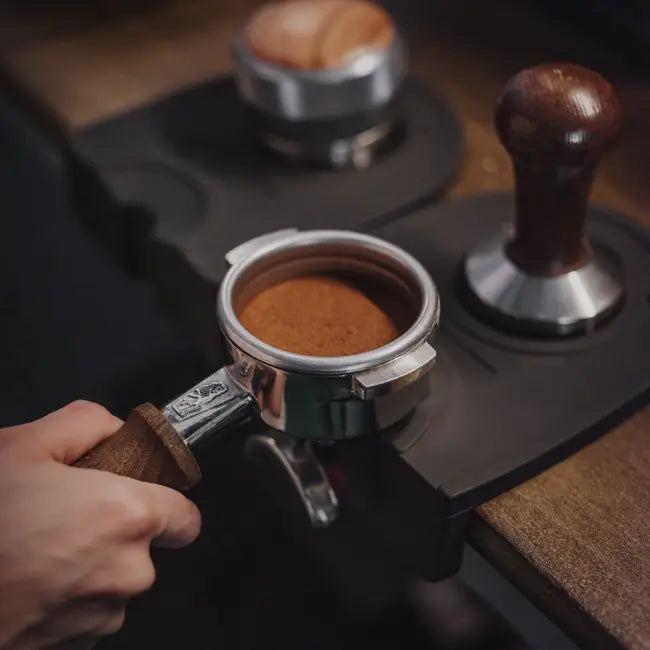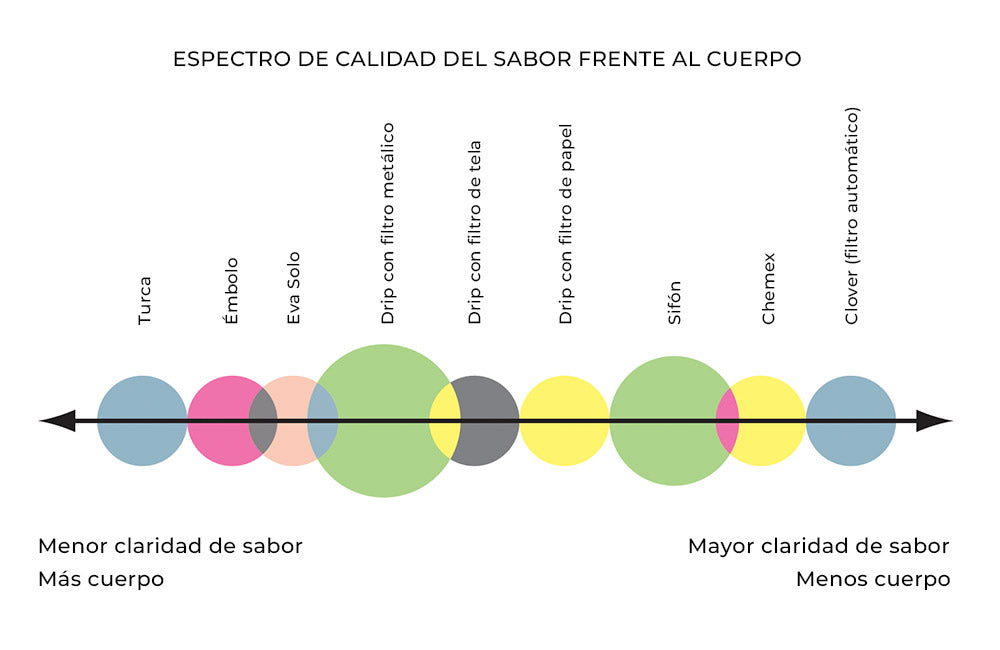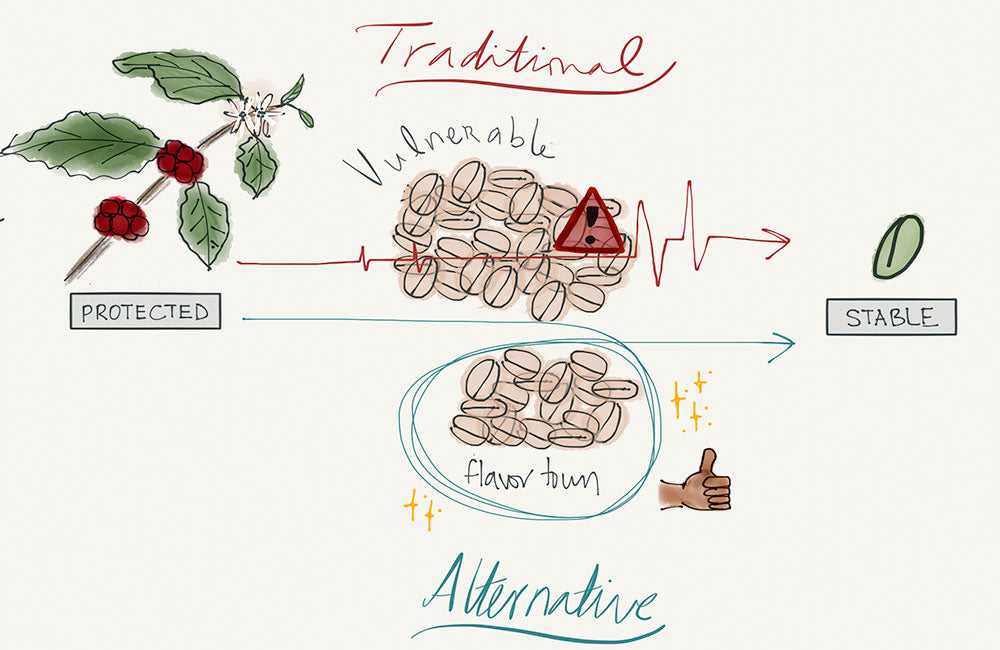El debate del tamaño de las partículas del café
Durante los últimos años, varios expertos en café de especialidad, científicos y fabricantes de molinos muy conocidos han medido y debatido públicamente sobre las distribuciones del tamaño de partículas (PSD) de la molienda. Varios incluso han alquilado o pedido prestadas máquinas caras que ofrecen mediciones relativamente precisas.
A pesar del creciente interés por la PSD, nuestro conocimiento de cómo afecta la geometría de las muelas es bastante limitado, y no creo que ninguno de nosotros tenga una idea clara de cómo es una PSD óptima.
Puede que seamos conscientes de querer menos finos para el café de filtro que para el espresso y existe el acuerdo generalizado de rechazar las partículas más grandes que la media (“boulders”, en inglés), pero, hasta donde yo sé, nadie ha cuantificado cuáles son los niveles de finos óptimos con precisión ni sabe demasiado sobre el impacto en la taza de los “microfinos” con respecto a los finos de mayor tamaño.
Algunas definiciones

Nominal peak: Pico nominalDensity of particle volume: Densidad del volumen de partículasFines: FinosBoulders: Partículas más grandes que la mediaFines peak: Pico de finosParticle diameter (μm): Diámetro de las partículas (μm)
Mientras tanto, gracias principalmente al trabajo de Jonathan Gagné, autor de The Physics of Filter Coffee, hemos logrado entender más sobre cómo afectan los finos al channeling y al flujo de líquido en los métodos de percolación.
Según Illy en Espresso Coffee: The Science of Quality, “las partículas más finas mejoran la superficie de extracción expuesta y las más gruesas permiten que el agua fluya”. En The Physics of Filter Coffee y en su blog Coffee Ad Astra, Jonathan profundizó en el papel de los finos en la percolación, incluidas dinámicas relacionadas con la migración de finos y el channeling. Hace poco, le pregunté a Jonathan qué piensa ahora mismo sobre los finos y contestó lo siguiente: “Cuando la proporción de finos es insuficiente, se generan huecos más grandes e irregulares entre las partículas”.
Jonathan reconoce que un exceso de finos puede provocar channeling y, por otra parte, su escasez deja vías de flujo abiertas demasiado grandes para que las partículas astringentes abandonen la cama de café. Los finos llenan los huecos entre partículas de mayor tamaño y ayudan a limitar la cantidad y quizá el tamaño de las vías de flujo de baja densidad en la cama de café.
No soy científico, pero cuento con más de 30 años de experiencia en café y he preparado más de un millón de tazas, así que he adquirido algo de conocimiento.
En esta entrada especulo sobre lo que llamo “la teoría de la media ideal de finos”.
Según mi experiencia
- Cuando la proporción de finos es excesiva, muchas vías de flujo se obstruyen fácilmente y el agua debe encontrar canales por los que rodear las zonas obstruidas. Dichos canales provocan una astringencia no deseada.
- Si la proporción de finos es insuficiente, se forman grandes vías de flujo en la cama de café y sale una cantidad desproporcionada de agua de la cama a través de esas vías, hecho que reduce la intensidad de la extracción y traslada componentes más grandes y astringentes a la taza.
- La cantidad de finos “media ideal” proporciona suficientes finos para nivelar el tamaño de los orificios entre las partículas de café más grandes sin que lleguen a ser tantos que se produzca un atasco excesivo y localizado.
- La cantidad de finos media ideal para una receta concreta es aquella que reduce al mínimo la astringencia.
- La extracción de espresso óptima requiere una mayor proporción de finos que en el caso de la percolación de filtro.
Tipos de muelas
Los molinos de café casi siempre usan uno de estos tres tipos de muelas: planas (disco), cónicas o de rodillo.
Las muelas planas suelen producir una cantidad reducida de finos. Entre las excepciones se encuentran las muelas “turcas” y otros tipos de muelas diseñadas para el espresso y el café turco; en el resto de este artículo, “muelas planas” se referirá a las muelas planas más comunes diseñadas para café de filtro. Las muelas cónicas suelen producir más finos que las planas. Los molinos de rodillo generan una cantidad media de finos y la proporción más reducida de “boulders”, si asumimos que los granos pasan por más de un conjunto de rodillos.
En Everything But Espresso, propongo la idea de que la claridad del sabor y el cuerpo siempre están en contraste. Esa afirmación ha superado la prueba del tiempo. Ya se cambie el método de elaboración, el tipo de filtrado o el molino, el aumento en la claridad siempre coincide con una pérdida de cuerpo y viceversa.

Este diagrama se publicó por primera vez en Everything But Espresso, 2009. En la actualidad, existe una variedad mayor de filtros de papel que cuando prepare este diagrama, por lo que el círculo de “drip con filtro de papel” sería mucho más grande. Es probable que haya intercambiado las posiciones de Clover y Chemex, pero espero que el lector entienda la esencia del diagrama.
Nota: cuando escribí Everything But Espresso, la Vac Pot, la Clover y la Eva Solo estaban muy de moda; si tuviera que actualizar el diagrama, eliminaría esos métodos de elaboración y añadiría Aeropress y NextLevel Pulsar.
Conclusión
No propongo a los baristas que usen muelas cónicas para los filtros manuales o que nunca utilicen muelas que generan muy pocos finos. Para determinar qué tipo de molino y muelas usar con un método, se deben tener en cuenta la proporción de finos, el método de elaboración y la efectividad de la cama de café como dispositivo de filtrado.
Cualquier barista informado debe plantearse qué busca en términos de equilibrio de claridad, cuerpo y astringencia, y elegir las muelas y el método de elaboración adecuados para conseguir dicho equilibrio.
Las preferencias personales variarán y, por supuesto, a mucha gente todo esto le parecerá demasiado tedioso o técnico. Pero, para algunos de nosotros, la complejidad interminable del café es lo que hace que sea tan divertido.

Estas imágenes representan estimaciones subjetivas, no se basan en datos irrefutables, ya que aún no existen estándares para medir de forma objetiva las tres cualidades.
Conical: cónicaULF: producción muy reducida de finosHU/flat burrs: muelas planasclaridad / cuerpo / astringencia
Sobre Scott Rao
Scott Rao es uno de las figuras prominentes en el mundo del café de especialidad. Es autor de varios libros, como “Manual del Barista Profesional”, "Everything but Espresso" y “The Coffee Roaster’s Companioin” escritos con la intención de ayudar a la industria a pivotar hacia una forma de entender el café más formada y científica. Gran parte de su tiempo la dedica a la consultoría de tostadores de café alrededor del mundo, impartir clases sobre el tueste de café y en diseñar equipos de café de última generación.
En Ineffable Coffee llevamos trabajando con Scott Rao desde 2018. Ha sido invaluable poder contar con su consejo y experiencia a través de los años. Fruto de esta colaboración nos alegra poder ofrecer este contenido en español.
Artículo escrito por Scott Rao, originalmente publicado en inglés en su blog y traducido por Ana Rubio Ramírez de coffeeandtranslation.com










